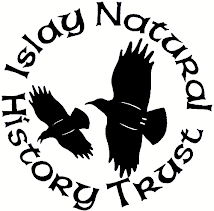Two scientists from the Wildfowl and Wetlands Trust have been on the island this week trying to catch Greenland Whitefronted Geese in order to mark them and be able to study their movements. This has been done before here, but not for many years, while birds marked elsewhere, e.g. Greenland, Iceland, and Ireland are regularly seen on Islay.
Yesterday lunchtime, a catch of 31 was made. It may not seem many but is actually more than had previously been marked on the island. The birds were marked with individually numbered metal and plastic rings and a plastic neck-collar. Two birds were given high-tec GPS collars which record their position within 20 metres every four hours and then transmit this information via mobile phone masts and thence to the scientists' computers. If there's no phone mast within range, the data are stored until there is. The solar-powered battery in the collar should last a number of years, potentially giving a mass of detailed information on where the birds stay during the winter, their migration routes via Iceland, and their breeding grounds in western Greenland.
Malcolm
 |
| Holding pens for the geese - the catch site is in the background beyond the rushes. Four cannons fired projectiles carrying the 30 x 15 metre net up and over the feeding geese. Because the geese in the holding pens are in the dark, they stay quiet and don't flap or struggle. |
 |
| A Whitefront waiting to be marked and measured. |
 |
| A high-tec collar being fitted. On the front is a solar panel to recharge the battery, and just above it a very small protrusion containing the battery, the GPS and the transmission device. The collar weighs c.40 grams (less than an ounce and a half). This goose weighed 3.025 kilograms or just over 6 and a half pounds. |
 |
| Once the geese are ringed, they are placed in a small dark tent and then released in batches. |
 |
| A marked goose in a field at Foreland. This was an old friend, C9L, marked in West Greenland in summer 1992 as an adult, and spending every winter on Islay from 1992-93 until it was found dead in January 2006, at an age of at least 15 years; the goose has clearly not been incommoded by the collar. It always wintered in the same area around Foreland. Some geese, like this one, are incredibly site-faithful. Others visit different wintering areas in different winters. There is much to learn from these marked birds. |






















No comments:
Post a Comment